Physical Address
304 North Cardinal St.
Dorchester Center, MA 02124
The clavicle functions as an anterior strut supporting the upper limb. The distal aspect of the clavicle articulates with the acromion, thus forming the acromioclavicular (AC) joint, via a posterolaterally oriented facet. The acromion has a reciprocal facet, which is oriented anteromedially. The AC joint is a diarthrodial joint and includes a capsule, articular cartilage, and synovium ( Fig. 12.1 ). An intra-articular disc is typically present, but its size and shape vary significantly. This intra-articular disc begins deteriorating in the second decade of life, and the joint itself undergoes an age-related degeneration.
The AC joint capsule is thin, but has regions that are thickened and are thought of as distinct ligaments: the superior, inferior, anterior, and posterior AC ligaments. The superior and posterior portions of the AC joint capsule are the thickest. They insert 2.8 mm laterally onto the acromial surface and extend onto the distal clavicle an average of 16 mm from the joint line. The AC ligament complex, of which the superior and posterior portions are the thickest and strongest, is the primary stabilizer of the AC joint in the horizontal plane. , , Vertical stability of the AC joint is maintained by the coracoclavicular (CC) ligament complex, which consists of the trapezoid and conoid ligaments ( Fig. 12.2 ). , Specifically, the conoid ligament is the greatest contributor to AC joint stability in the vertical plane. The conoid ligament is the more medial ligament and attaches to the clavicle at the conoid tubercle (a readily visible radiographic landmark on the inferior clavicle). Distally, it attaches to the posterior-most aspect of the dorsum of the coracoid and extends to the posterior coracoid precipice (the vertical component of the posterior coracoid as it blends with the supraspinatus fossa). The trapezoid ligament is the more lateral of the CC ligaments and attaches to the undersurface of the clavicle along the trapezoid line (an oblique ridge that runs from the conoid tubercle anterolateral towards the anterior aspect of the AC joint) and to the coracoid base anterior and lateral to the conoid ligament. Familiarity with the attachments of the CC ligament complex is essential for successful reconstruction of the AC joint. The trapezoid and conoid ligaments originate 2.5 and 4.6 cm from the lateral edge of the clavicle, respectively. Alternatively, this represents a constant ratio of 17% and 31% from the lateral edge of the clavicle, respectively, which is consistent regardless of race or sex. ,
The deltotrapezial fascia (DTF) may also play a role in AC joint stability. As fibers of the superior AC ligament weave into the DTF, it may act as a static and/or dynamic stabilizer of the AC joint. Although some authors have suggested that additional injury to the DTF may be responsible for the increased displacement observed between Rockwood Type III and V injuries, strong biomechanical and clinical studies supporting this hypothesis are lacking. In a recent cadaveric study, Pastor et al. found a relatively small but statistically significant increase in translation and rotation following sectioning of the AC ligaments and the DTF, compared with isolated sectioning of the AC ligaments.
AC joint injuries typically occur as a result of direct trauma to the shoulder girdle with the arm adducted at the side. An inferiorly directed force is applied to the acromion and scapula. This drives the entire scapula anteriorly, medially, and frequently inferiorly, causing variable injury to the AC and CC ligament complexes. Indirect trauma, such as a fall on an outstretched hand, may also lead to AC joint injury by driving the humeral head superiorly into the undersurface of the acromion, also resulting in injury to the AC and CC ligament complexes.
AC joint injuries can be thought of as a continuum of injury severity, with sequential failure of the AC and CC ligaments. Low-grade injuries typically only involve the failure of the, comparatively less stout, AC ligament complex and lead to instability of the AC joint in the horizontal plane, but do not lead to significant instability in the vertical plane if the CC ligament complex remains intact. The vertically oriented CC ligament complex is capable of partially compensating for AC ligament complex insufficiency with some resistance to force in the horizontal plane. In this injured scenario, the conoid ligament becomes the primary stabilizer to anteriorly directed forces, while the trapezoid ligament becomes the primary stabilizer to posteriorly directed forces. Higher grade AC joint injuries lead to both failure of the AC ligaments and partial or complete failure of the CC ligaments with resultant instability in the horizontal and vertical planes. Ultimately, failure of the AC and/or the CC ligaments leads to abnormal AC joint kinematics and load transmission, which may result in pain, instability, and accelerated joint degeneration. Additionally, as the clavicle functions as an anterior strut to support the scapula, AC joint instability may contribute to the development of scapular dyskinesis.
The Rockwood classification remains the most widely used system guiding management of AC joint injuries. First published in 1984, it expanded on the previous work of Cadenat, Tossy, and Allman. It is a radiographic classification system that focuses on direction and extent of displacement at the level of the AC joint. The extent of vertical displacement is determined by measuring the CC distance of the injured extremity and comparing it with the presumably normal CC distance of the contralateral extremity. It is imperative that the assessed films be taken with the patient in the upright position as the extent of the ligamentous injury is inferred from the displacement induced by gravity upon the shoulder girdle.
Rockwood’s six-part classification system can be thought of as a continuum of increasing injury severity ( Fig. 12.3 ). A Type I injury involves a sprain of the AC joint without a complete tear of either the AC or CC ligament complexes; anteroposterior (AP) shoulder or Zanca view radiographs reveal no increase in CC distance. A Type II injury involves a complete tear of the AC ligament complex, but the CC ligament complex remains intact; radiographs reveal an increase in CC distance <25%. A Type III injury involves a complete tear of both the AC and CC ligament complexes; radiographs reveal an increase in CC distance between 25% and 100%. A Type IV injury involves posterior displacement of the lateral aspect of the clavicle. Radiographs may look relatively normal in the AP plane, but an axillary view will reveal posterior displacement of the lateral aspect of the clavicle in relation to the acromion. A Type V injury also involves a complete tear of both the AC and CC ligament complexes, but is significantly more displaced than a Type III injury. The distal clavicle is typically incarcerated in the DTF. Radiographs reveal an increase in CC distance in excess of 100%. A Type VI injury involves a complete tear of both the AC and CC ligament complexes accompanied by displacement of the lateral aspect of the clavicle inferior to the coracoid or acromion. This is an exceedingly rare injury.
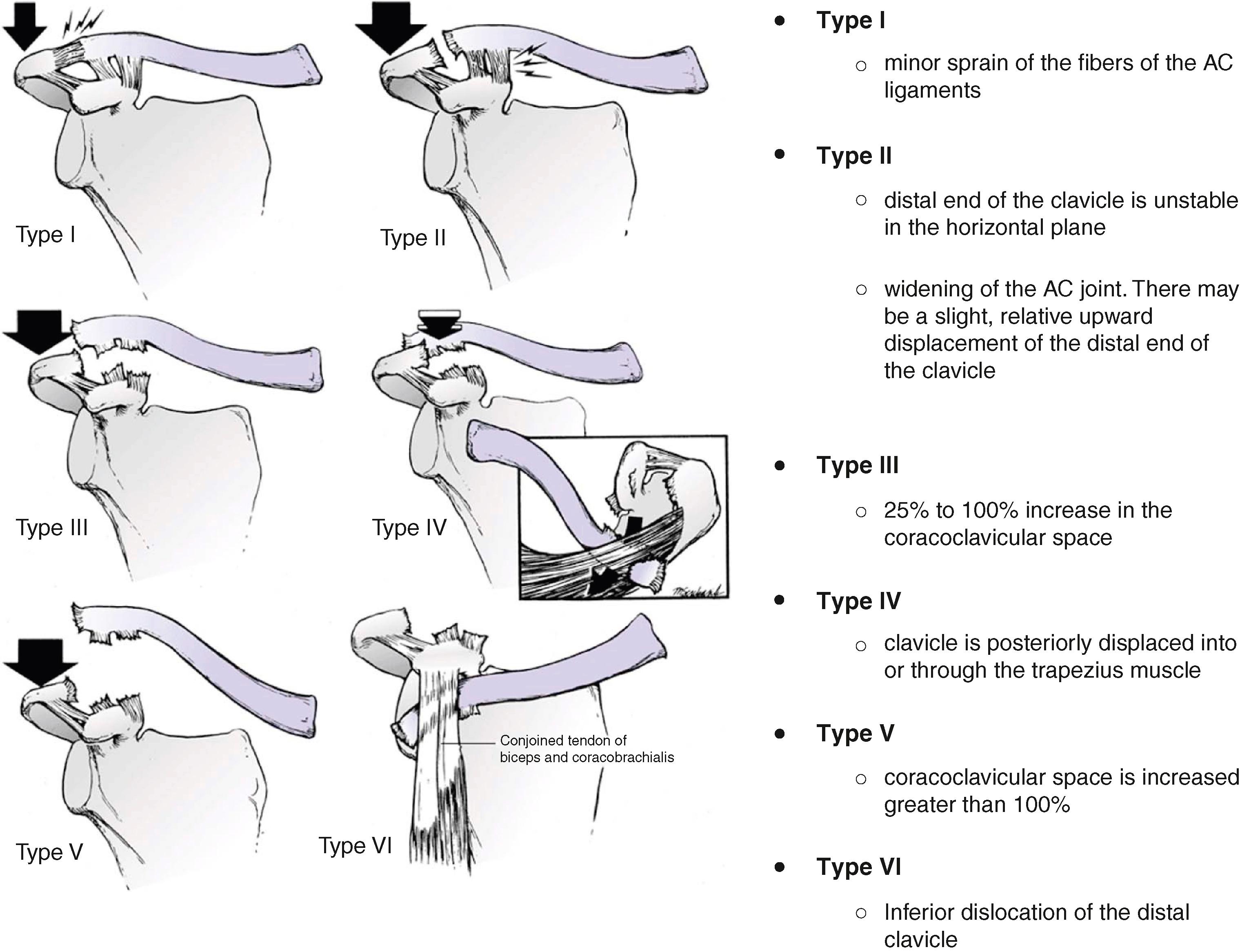
Despite its widespread use, the Rockwood classification does have certain limitations; it has been criticized for being a purely radiographic system attempting to infer and stratify a soft tissue injury. In particular, the optimal management of Type III injuries remains a source of significant controversy. , , In a recent consensus statement, The International Society of Arthroscopy, Knee Surgery and Orthopaedic Sports Medicine (ISAKOS) proposed subdividing Type III injuries into Type IIIA (stable) and Type IIIB (unstable) injuries. Type IIIB injuries are differentiated from Type IIIA injuries on the basis of functional criteria such as persistent pain, rotator cuff weakness, decreased flexion and abduction, scapular dyskinesis, and a positive cross-body adduction view (Basamania view). , They argue that this modified Rockwood classification may help with early identification of the subset of patients with Type III injuries who would benefit from early surgical management.
AC joint injuries are common and account for up to 9% of shoulder injuries. , Forty-four percent of these injuries occur in the third decade of life, and they are five times more common in men than in women. Athletes are at increased risk compared with the general population, especially those participating in contact sports such as hockey, wrestling, rugby, and American football. , Falls onto the shoulder from cycling, skateboarding, skiing, and snowboarding are also common etiologies. Most acute injuries will be accompanied by pain, tenderness, and swelling of the AC joint. Patients typically present with the arm adducted and supported to alleviate the pain. They should be examined in a standing or sitting position as the weight of the extremity will allow full appreciation of the deformity ( Fig. 12.4 ). High-grade injuries may be associated with significant deformity and skin tenting over the distal clavicle. Pain and tenderness along the trapezius muscle may also be observed in high-grade injuries due to soft-tissue injury and stripping of the DTF. Pain to palpation over the AC joint is typical. Cross-body abduction of the arm, which loads the AC joint, can create pain or instability of the distal clavicle. A shrug test has also been described, which may help differentiate a Type III injury from a Type V injury. If the patient is capable of reducing their AC joint with a shoulder shrug, this indicates an intact DTF and suggests a Type III injury. The scapulothoracic function should also be assessed when pain permits. Scapular dyskinesis may be observed in patients presenting with Type II–VI injuries and is often associated with ipsilateral prominence of the medial scapular border due to scapular internal rotation and/or anterior tilt.
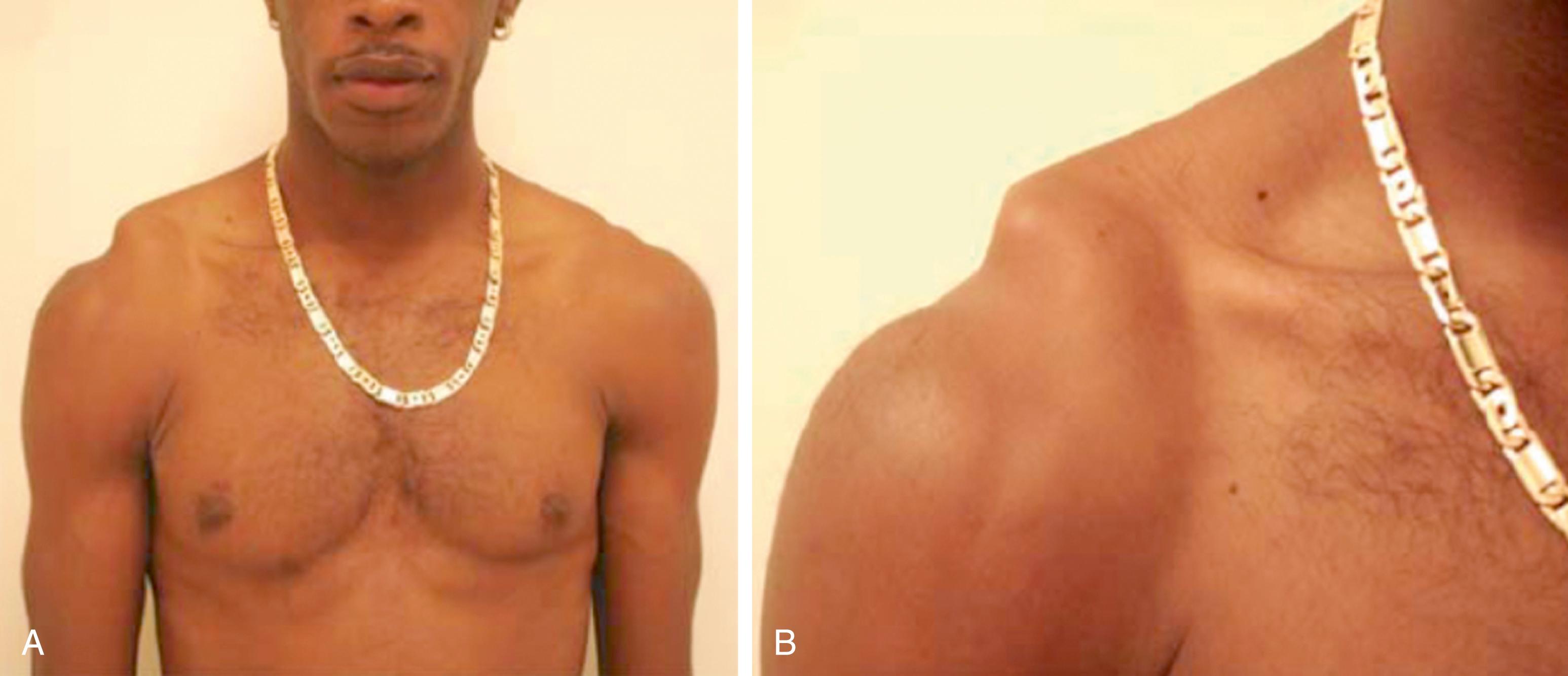
A thorough examination, including a neurovascular assessment, of the appendicular and axial skeleton should be performed to rule out associated injuries. In recent years, there has been increased awareness of concomitant intra-articular glenohumeral injuries. , These injuries occur in 15%–53% of patients presenting with high-grade (Types III–VI) AC joint injuries. Superior labrum from anterior to posterior (SLAP) tears and rotator cuff tears were among the most commonly identified lesions. While SLAP tears and rotator cuff tears are common findings in an asymptomatic population and the exact connection to the AC joint injury remains unclear, at least one group, Jensen et al., felt that 12% of their patients had concomitant glenohumeral pathology requiring surgical intervention. Factors that increase the likelihood of concomitant glenohumeral pathology include advanced age, chronicity, and high-grade injury (especially Type V). ,
Radiographs are the initial imaging modality of choice and should include a standard shoulder series (AP, scapula Y, axillary). Particular attention should be paid to the axillary view to rule out posterior displacement of the clavicle (Type IV injury) ( Fig. 12.5 ). A Zanca view should also be obtained as it provides the most accurate radiographic assessment of the AC joint. The X-ray beam is directed with a 10- to 15-degree cephalic tilt and penetration strength is decreased by half compared with a standard AP shoulder radiograph to avoid overexposure of the AC joint. A bilateral Zanca view allows visualization of both AC joints on a single X-ray cassette. Displacement is assessed by measuring the ipsilateral CC distance and comparing it with the CC distance on the uninjured contralateral side on upright films ( Fig. 12.6 ). A side-to-side difference >25% signifies a complete disruption of both the AC and CC ligament complexes. For reference, the normal CC distance ranges from 1.1 to 1.3 cm. The Stryker notch view is taken with the patient supine and the X-ray cassette beneath the affected shoulder ( Fig. 12.7 ). The palm of the affected arm is placed on the superior aspect of the head, with forward flexion of the shoulder just beyond 90 degrees and slight internal rotation. The X-ray tube is tilted 10 degrees cranially and centered over the coracoid process. The Stryker notch view provides an excellent view of the coracoid and may be considered to diagnose a coracoid fracture in the setting of a normal CC distance despite a complete AC joint dislocation.
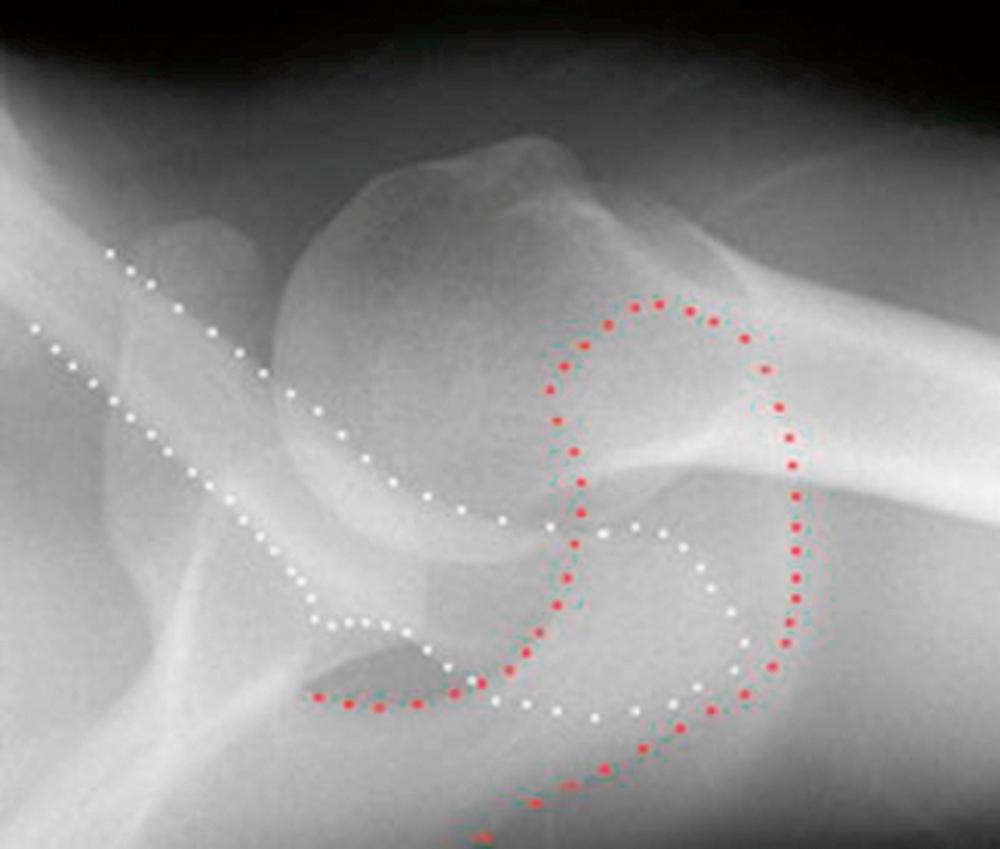
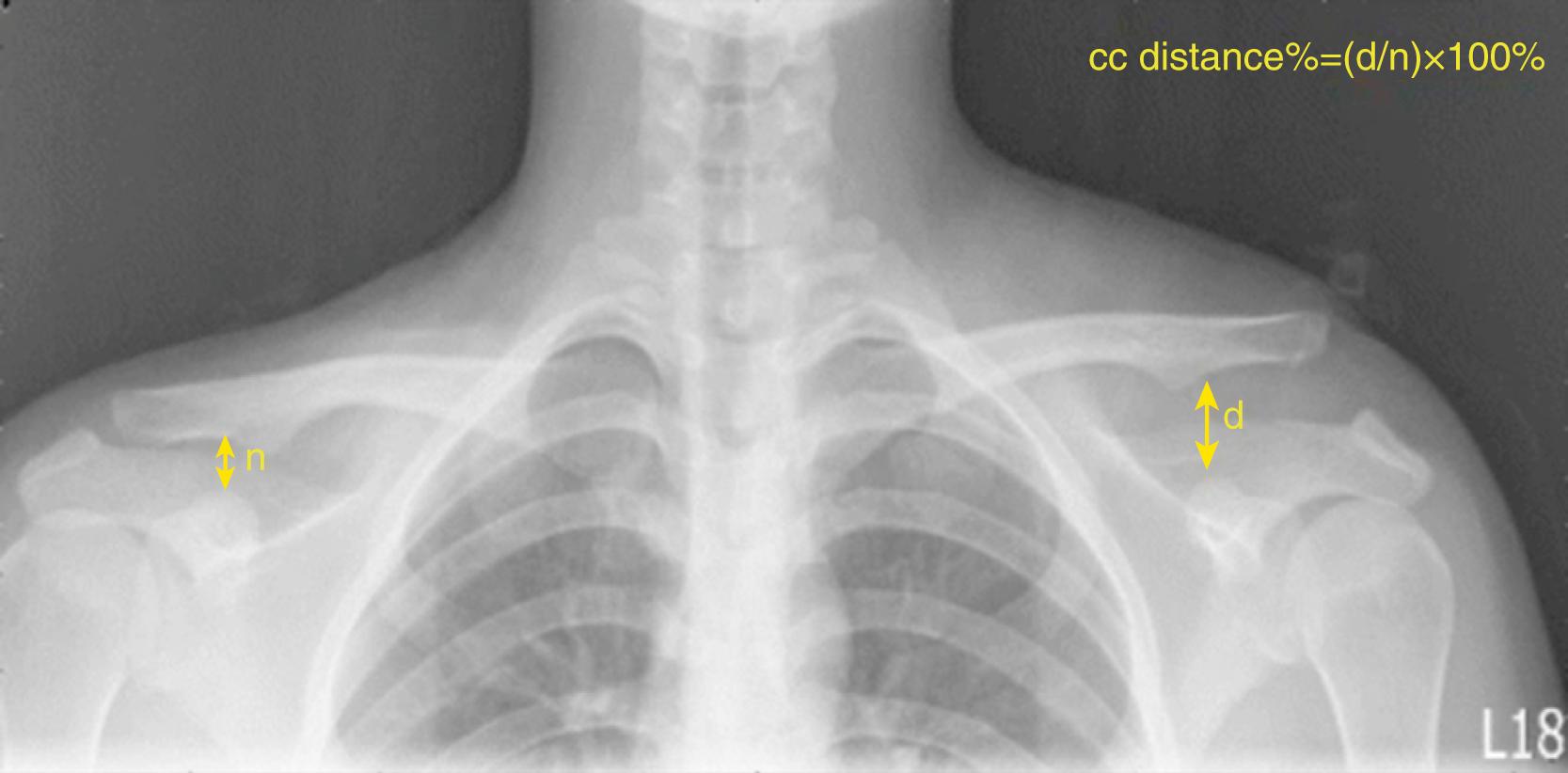
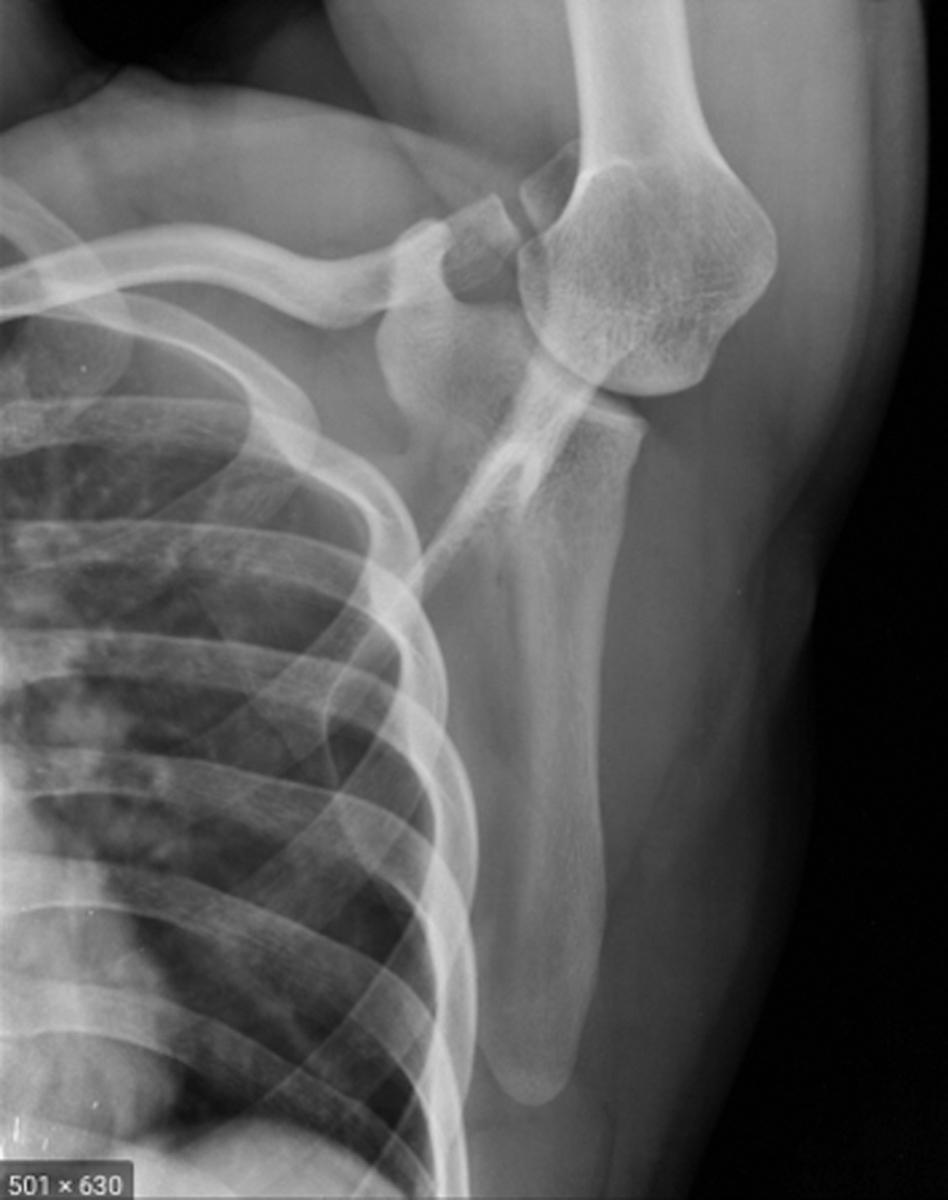
Two additional views, the Alexander view and the Basamania view, characterize overlap of the distal clavicle in relation to the acromion in cross-body adduction and scapula internal rotation. Identification of overlap on these stress views suggests clinically relevant instability of the AC joint. The Alexander view is taken with the patient standing. The affected shoulder is shrugged forward, and the arm is adducted across the chest with the hand placed in the contralateral axilla. The affected shoulder is pressed against the X-ray cassette, with the uninjured shoulder creating an angle of 30–35 degrees with the cassette. The X-ray tube is angled 15 degrees caudad and the beam is directed at the coracoid. , A similar view, known as the cross-body adduction (Basamania) view, described by Garrigues et al., is an AP view of the AC joint obtained with the patient standing against the X-ray cassette. The arm is adducted across the chest, with the shoulder flexed to 90 degrees. In a recent consensus statement, the ISAKOS has recommended obtaining a cross-body adduction (Basamania or Alexander) stress view to differentiate between stable (Type IIIA) and unstable (Type IIIB) injuries; instability is confirmed if the clavicle overlaps the acromion on this projection ( Fig. 12.8 ).
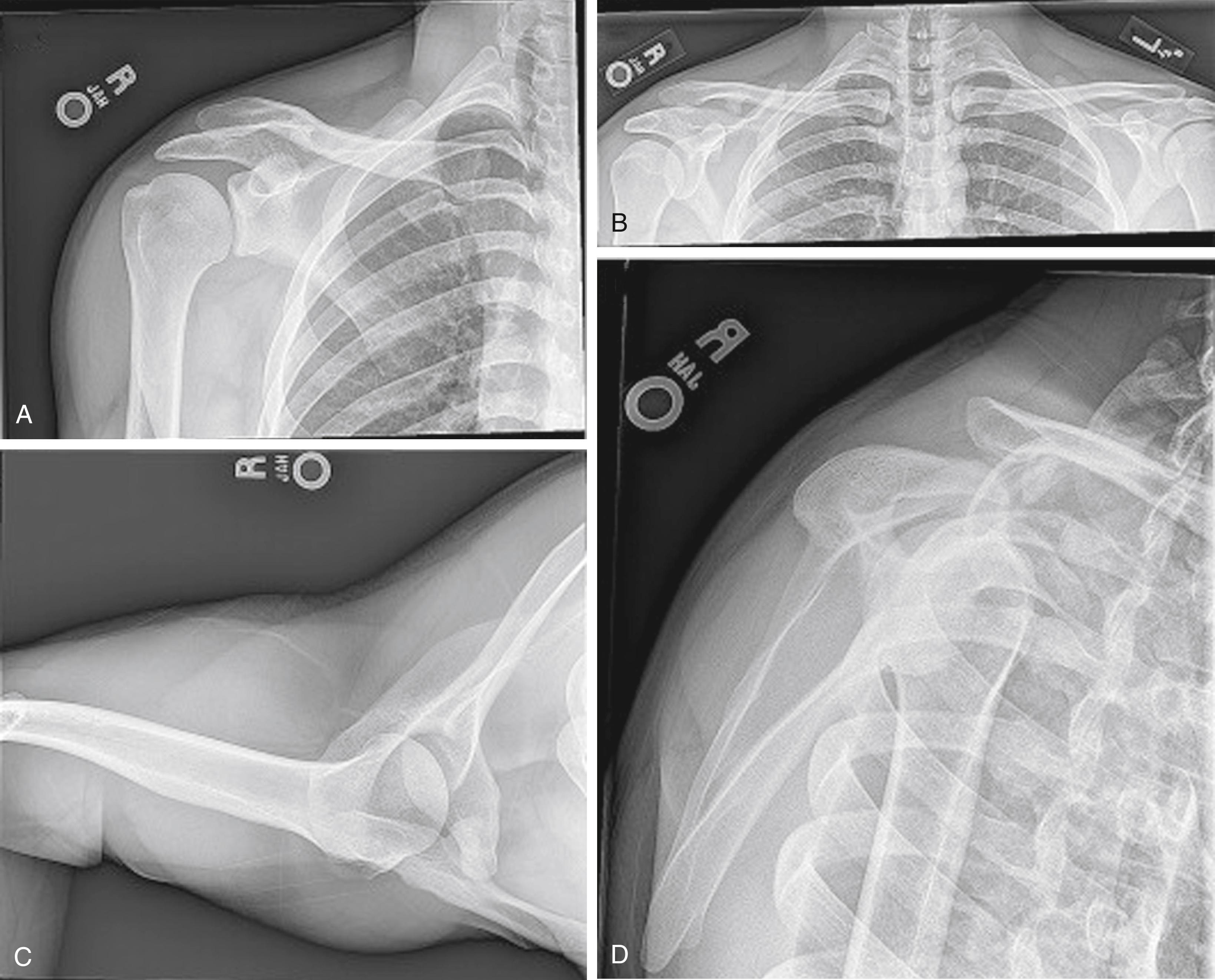
The cortical ring sign, described by Garrigues et al., is a useful view that can be obtained intraoperatively to assist in targeting the base of the coracoid for devices that include fixation into the coracoid base including the Bosworth screw, suture anchors, or as an augment to arthroscopically assisted “button” devices such as the TightRope (Arthrex, Naples, FL, USA) or ENDOBUTTON (Smith & Nephew, Memphis, TN, USA). , The fluoroscopic C-arm is arched over the shoulder and centered on the coracoid in a slight anterolateral to posteromedial direction until the coracoid base is visualized as a ring, which represents the cortical ring sign ( Fig. 12.9 ). Specifically, the X-ray beam should be perpendicular to the medial border of the scapula in the parasagittal plane and approximately 45 degrees off the axis of the scapular spine in the axial plane. While a superiorly directed force is applied to the arm by an assistant to reduce the AC joint, the primary surgeon can confidently drill the fixation trajectory into the center of the cortical ring under fluoroscopic guidance, thus maximizing fixation within the coracoid base, using a uniplanar view.

Weighted stress radiographs have previously been described in the literature, but they are not routinely performed in the acute setting as they are painful and rarely influence management. , The role of magnetic resonance imaging (MRI) in the management of acute AC joint injuries remains undefined at this time. However, given the high incidence of concomitant intra-articular glenohumeral pathology associated with high-grade injuries, some authors have proposed that obtaining a preoperative MRI may assist in preoperative planning. ,
The management of acute AC joint injuries remains a topic of intense debate within the orthopedic community. , , However, most authors agree that acute low-grade (Rockwood Types I–II) injuries should be treated nonoperatively. , , , , In a study of 134 patients with Types I–II injuries, Park et al. noted that symptoms typically resolved within 6 weeks. Although nonoperative treatment remains the standard of care for Types I–II injuries, Mikek reported that approximately half of the patients still experience some degree of pain and dysfunction at a mean of 10 years following the injury. Similarly, Mouhsine et al. determined that one-third of patients with low-grade injuries treated nonoperatively complain of persistent pain and instability at long-term follow-up. The severity of symptoms does not correlate with the degree of radiographic displacement. Thus the long-term disability associated with Types I–II injuries may be underappreciated at this time.
Acute high-grade injuries, particularly Type III injuries, have been the focus of the ongoing debate due to a lack of high-level evidence guiding management of Types III–VI injuries. , , , A recent Cochrane Review by Tamaoki et al. concluded that there was insufficient evidence to determine the relative effects of operative versus nonoperative treatment of high-grade AC joint injuries. Only three studies, published between 1975 and 1989, met the authors’ inclusion criteria. Furthermore, these studies included surgical techniques such as CC screw and K-wire fixation that are no longer commonly performed today due to their high complication rates. Numerous recent systematic reviews and meta-analyses have echoed the Cochrane Review’s findings. , ,
In comparison, the randomized controlled trial published in 2015 by the Canadian Orthopaedic Trauma Society (COTS), which was not included in the Cochrane Review, has been much more impactful. They reported no clinically significant differences between nonoperative and operative management of acute (<4 weeks) high-grade (Types III, IV, and V) AC joint injuries at 2-year follow-up. All patients randomized to operative management were treated using hook plate fixation. Return to work was quicker and outcome scores were greater at 6 weeks, 3 months, and 6 months in the nonoperative group. However, the superiority of nonoperative treatment was not sustained beyond this time point, with no difference identified at the 1- and 2-year follow-up. Although the COTS trial supports initial nonoperative management of Type III–V injuries, the authors’ failure to report the percentage of Type III, IV, and V injuries included in the study significantly affects our ability to interpret the results. Including a disproportionate number of Type III injuries within the study, which may be more amenable to nonoperative treatment, could potentially skew the results and lead to a Type II error.
Nevertheless, the results of the COTS trial are supported by a randomized controlled trial published by Larsen et al. in 1986. They concluded that nonoperative treatment of acute high-grade AC joint injuries resulted in faster rehabilitation than operative treatment (K-wire fixation), but that clinical outcomes were equivalent at 13 months.
Murray et al. recently published the results of the ACORN trial, a prospective randomized controlled trial comparing operative versus nonoperative treatment of acute (<2 weeks) Type III and IV injuries in young patients (16–35 years old). Patients randomized to operative management were treated with loop suspensory fixation (LSF) using a double TightRope (Arthrex) technique. The results of their study also mirror those of the COTS trial; they found no significant difference in outcomes between operative and nonoperative treatment after a minimum 1-year follow-up, despite a faster initial recovery in the nonoperative group. Five patients from the nonoperative group required operative intervention due to persistent disability or cosmetic concerns, but the authors were unable to identify patient or injury-related factors that predicted a poor outcome with nonoperative treatment.
A prospective randomized controlled trial by Joukainen et al. informs on the long-term outcomes of AC joint injuries. They reported no difference in clinical outcome scores between operative and nonoperative treatment of Type III and V injuries at long-term follow-up of 18–20 years. Although they noted increased deformity and instability in the nonoperative group, there was no difference in the prevalence of AC joint degeneration at long-term follow-up. Results of this study should be interpreted with caution considering that operative treatment involved direct ligamentous repair and temporary transarticular K-wire fixation, which is a technique that has largely been abandoned due to a high complication rate.
Although the literature seems to support nonoperative treatment of most high-grade AC joint injuries, a subset of patients with these injuries will fail nonoperative treatment and require surgical intervention. This is of particular concern as delayed AC joint reconstruction following a failed trial of nonoperative treatment yields inferior results compared with acute AC joint reconstruction. However, nonoperative treatment of AC joint injuries provides good-to-excellent outcomes in most cases, and these studies should not be interpreted as a justification to pursue widespread operative management. , Thus the challenge is to identify the subset of patients who may benefit from early operative treatment.
Become a Clinical Tree membership for Full access and enjoy Unlimited articles
If you are a member. Log in here